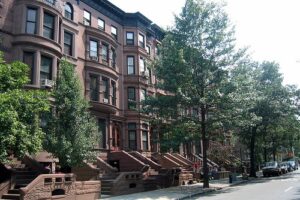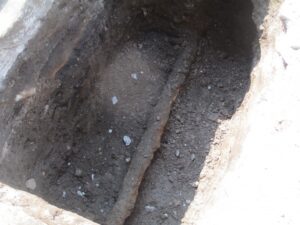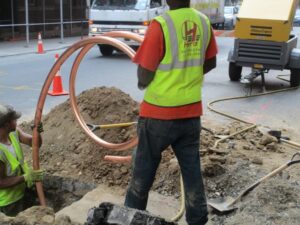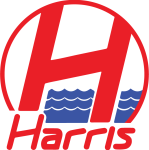A Brooklyn Homeowner was recently given alarming news after a routine doctor’s appointment for her two year old son. The homeowner had moved into a new home in Brooklyn six months prior, and the doctor’s professional opinion was that the existing lead water main was the primary factor for her son’s diagnoses. It was strongly recommended that the water line was replaced with a new copper water main.
Harris Water Main and Sewer Contractors were hired to replace the existing ¾” lead water main with a new 1” copper pipe. The homeowner called Harris Water in a panic as she was on her way home from the doctor’s appointment, she was surprisingly notified that the water main could be replaced the very next day and her son would be on his way to recovery.
|
Old lead water main |
Installing copper pipe |
The Harris Water installation crew showed up at the house early the next morning and started to excavate the roadway where the lead pipe was connected to the city water main. The other crew members began digging on the property in preparation for the new copper water main installation. After 4 hours of digging, the crew was now ready to make the water main tunnels from one hole to the next. The new water main was now pulled through and hooked up to the existing copper pipe inside the house. The entire water main installation was completed by 3pm the same day, leaving a relieved Brooklyn homeowner.
What is lead poisoning?
Lead poisoning occurs when lead builds up in the body and may occur within children and adults who breathe or swallow dust/water containing lead. The human body has no use for lead and quickly affects the entire body. Common symptoms are a lack of appetite, feeling sluggish, weight loss, vomiting etc.
How to reduce exposure to lead from pipes
- Run water for a minimum of 15-30 seconds until the water becomes cold before using, the approximate additional cost is $1 per month to your water bill.
- Have the water tested by a certified laboratory.
- Use only cold water when cooking or drinking
- Remove solder and debris from all plumbing materials that have recently been installed in the home. Remove faucet strainers and run thee water for 4 minutes, continue to do so on a periodic basis.
Lead in drinking water
Lead is not commonly found in drinking water but may enter the water supply through corroded pipes. Lead water lines have not been installed in NYC since 1961 and the use of lead solder was banned in 1987. Most homes built prior to 1987 are more likely to have lead in pipes even if “lead free”, the plumbing may contain up to 7% lead. The most common lead issue is when dealing with chrome or brass plated fixtures which can result in a large amount of lead in drinking water.
What is NYC doing about lead levels in our drinking water?
The DEP runs a program focused on reducing the levels of lead in drinking water, primarily focusing on homes with lead water lines and lead soldering. The NYC DEP monitors lead levels on a regular basis by adjusting pH levels of our water to a specified range that assists in reducing corrosion in water. The program also adds phosphoric acid to create a protective film on the pipes which also reduces the release of lead from the water lines. Due to these efforts the levels of lead in NYC have been dropping on a regular basis.
Park Slope Brooklyn – A brief history
Courtesy of Wikipedia
 Park Slope is an affluent neighborhood in southwest Brooklyn. Park Slope is roughly bounded by Prospect Park West to the east, Fourth Avenue to the west, Flatbush Avenue to the north, and Prospect Expressway to the south. Generally the section from Flatbush Ave. to Garfield Place (the “named streets”) are considered the “North Slope”, 1st St. through 9th Street is considered the “Center Slope” and 10th St. through the Prospect Expressway is the “South Slope. The neighborhood takes its name from its location on the western slope of neighboring Prospect Park. Fifth Avenue and Seventh Avenue are its primary commercial streets, while its east-west side streets are populated by many brownstones.
Park Slope is an affluent neighborhood in southwest Brooklyn. Park Slope is roughly bounded by Prospect Park West to the east, Fourth Avenue to the west, Flatbush Avenue to the north, and Prospect Expressway to the south. Generally the section from Flatbush Ave. to Garfield Place (the “named streets”) are considered the “North Slope”, 1st St. through 9th Street is considered the “Center Slope” and 10th St. through the Prospect Expressway is the “South Slope. The neighborhood takes its name from its location on the western slope of neighboring Prospect Park. Fifth Avenue and Seventh Avenue are its primary commercial streets, while its east-west side streets are populated by many brownstones.
Park Slope features historic buildings, top-rated restaurants, bars, and shops, as well as proximity to Prospect Park, the Brooklyn Academy of Music, the Brooklyn Botanic Garden, the Brooklyn Museum, the Brooklyn Conservatory of Music, and the Central Library (as well as the Park Slope branch) of the Brooklyn Public Library system.
The neighborhood had a population of about 62,200 as of the 2000 census, resulting in a population density of approximately 68,000/square mile, or approximately 26,000/square kilometer.
Park Slope is considered one of New York City’s most desirable neighborhoods. In 2010, it was ranked number 1 in New York by New York magazine citing its quality public schools, dining, nightlife, shopping, access to public transit, green space, safety, and creative capital, among other aspects.
It was named one of the “Greatest Neighborhoods in America” by the American Planning Association in 2007, “for its architectural and historical features and its diverse mix of residents and businesses, all of which are supported and preserved by its active and involved citizenry.






















